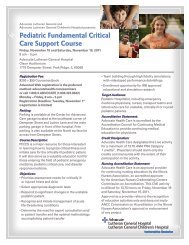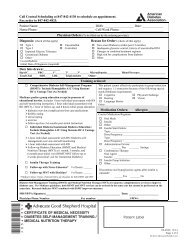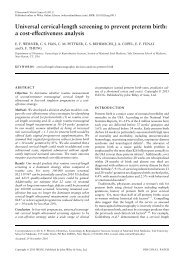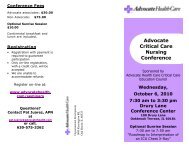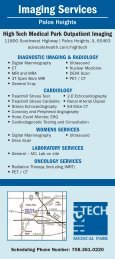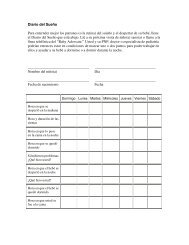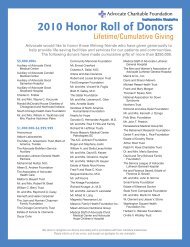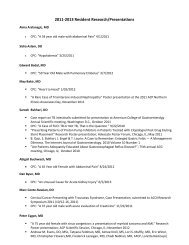RHABDOMYOLYSIS & CRUSH SYNDROME - Advocate Health Care
RHABDOMYOLYSIS & CRUSH SYNDROME - Advocate Health Care
RHABDOMYOLYSIS & CRUSH SYNDROME - Advocate Health Care
You also want an ePaper? Increase the reach of your titles
YUMPU automatically turns print PDFs into web optimized ePapers that Google loves.
ABDOMYOLYSIS AND <strong>CRUSH</strong> SYNDROMRhabdomyolysis = Dissolution of Skeletal MuscleTrauma and Crush Injuries is one of Many Categories ofCauses for Rhabdomyolysis• Car Injuries/Physical Assault/Collapsed Buildings/EarthquakesNontraumatic Causes: Exertion, Prolonged ImmobilizationArterial Occlusion, Infection, Hyperthermia, Metabolic andElectrolyte Disorders, Drugs & Toxins, Genetic DefectsAcute Kidney Injury (AKI) Most Serious Complication ofRhabdomyolysisCrush Injury Complicated by AKI Referred to as “CrushSyndrome”
Case PresentationHistoryJR is a 22-year-old Hispanic man without previous medical history. While atwork, allegedly as a cat burglar, he fell upside down deep into a ventilationshaft and became stuck. His timing was chosen to prevent detection,consequently he was not discovered until 24 hours later. His body wascompressed against pipes and the vent walls on all sides. JR has a history ofcocaine abuse and had used cocaine just prior to falling into the ventilationsystem. He drinks a six pack of beer and smokes one pack of cigarettes daily.ExamIn the emergency room he was awake and complained of diffuse body pain.Blood pressure was 70 systolic and heart rate 130/min. He had diffuse bruisingand areas of skin necrosis, more severe over the left shoulder, upper back,chest wall and over the left lower extremity including thigh, calf, and leftAchilles. Swelling of the left shoulder extended into the neck but the musclecompartments were not tense. He had limited range of motion of the shoulderand neck. Distal extremities were cool bilaterally but peripheral pulses wereintact and capillary refill was less than two seconds.
Case PresentationcontLaboratory studiesPotassium 5.9 mEq/L, Bicarbonate 15 mEq/L, Anion gap 33, pH 7.26, pCO232, Lactate 3.5 mEq/L, BUN 39 mg/dL, Creatinine 5.1 mg/dL, CPK 63,440,Calcium 6.1 mg/dL, Phosphorus 7.4 mg/dL, Uric Acid 13.6 mg/dL, AST 1,748U/L, ALT 355 U/L, Alkaline phosphatase 108 U/L, Albumin 3.1 mg/dL, WBC28,000/mL, hemoglobin 19.8 gm/dL. Urinalysis: cloudy and grossly bloody,pH 5, 4+protein, 4+blood, trace ketones, sediment revealed no RBC’s.Toxic screening was positive for cocaine and benzodiazepine.Hospital CourseThe patient was volume resuscitated with 3L of wide open isotonic salinein the emergency room followed by half normal saline with 75 mEq/L ofbicarbonate at 250 mL/hour. Over 24 hours blood pressure stabilized,central venous pressure increased to 15 cm, but urine output remainedless than 50 cc/hr and he developed progressive azotemia (BUN 37 mg/dL,creatinine 8.0 mg/dL), with severe metabolic acidosis and hyperkalemia. IVfluids were reduced and acute daily hemodialysis was initiated on hospitalday two. After five days, dialysis was reduced to three times/week. Onhospital day 12, urine output increased and dialysis treatments werediscontinued. At discharge, BUN was 25 mg/dL and creatinine 1.7 mg/dL.
KEY POINTS OF CASE PRESENTATIONYoung and Male•Accelerated Rise in CreatinineProlonged Extraction TimeMultiple Risk Factors for RhabdomyolysisHypovolemic and Hemo-Concentrated•Volume Resuscitation CriticalSigns and Symptoms of Muscle Injury“Bloody” Urine (Pigmenturia) Without Red Blood CellsElevated Serum Muscle EnzymesCharacteristic Metabolic Features•Acidosis/Hyperkalemia/Hyperphosphatemia/HypocalcemiaOliguria (Prevented Use of Mannitol)Catabolic and Need For Early DialysisEventual Recovery
EPIDEMIOLOGY• Rhabdo-Induced AKI Common• 7-10% of all AKI in US• Risk for AKI with Rhabdo Varies Widely• 10-50% overall but 30-50% of crush victims• 2-10% of all non-fatal injuries in catastrophic earthquakes• Most common with drugs, alcohol, trauma• Risk Factors In Crush Syndrome• Severity and location of injury General correlation between CPK Low incidence when CPK < 5000• Volume Status• Time To Extraction and Hospitalization• Long-Term Survival, Chance for Renal RecoveryGood
083 CONSECUTIVE TRAUMA VICTIMSDivided By Peak CPKBrown et al, J Trauma 2004Copyright © 2009 Wolters Kluwer
ADJUSTED ODDS RATIO FOR RENAL FAILURE AT EACHINCREMENT OF PEAK CKDivided By Peak CPKError bar represents 95% confidence interval Brown et al, J Trauma 2004
BAM EARTHQUAKERisk For Renal FailureWithoutWith AKIHatamizadeh et al, AJKD, 2006
BAM EARTHQUAKERisk For Renal FailureWithoutWith AKIHatamizadeh et al, AJKD, 2006
<strong>RHABDOMYOLYSIS</strong>ovolemia (Sequestration)Activationof RAS &SNSenalasoconstrictionEndothelial DamageDICRBFRelease of Cytokines, Myoglobin, CK, Electrolytes, UrateToxic Free Radicals/DICIschemiaHeme-Protein Scavages NOlipid peroxidationDirect TubularCytotoxicity(Proximal)Myoglobin Concentrated in TubuleReduce Urine Flow RateOxidized to Ferric + OH .(Acid Urine pH)(Low Urine pH)precipitates withTamm-Horsfall ProtTubularObstruction(Distal)↓ FiltrationBack LeakBlocked Flow↓ GFR
ONSEQUNCES OF <strong>CRUSH</strong> SYNDROM• Early• Hypovolemic Shock• Arrhythmias (Hyperkalemia & Hypocalcemia)• Late• Acute Kidney Injury• Compartment Syndrome• Septic Shock• ARDS• Coagulopathies, Bleeding and DIC• Psychological Trauma
PRESENTING CLINICALMANIFESTATIONS• Muscle Pain, Weakness, Tenderness• Swelling or Skin Changes of PressureNecrosis of• Compartment Syndrome• Hypovolemia• Oliguria/Anuria Common• Dark Urine/Clear Plasma
BIOCHEMICAL MANIFESTATIONS• Urine: Red-Brown (Supernatant)• Dipstick positive for Heme• Urine myoglobin (freely filtered)• No RBCs in sediment• Pigmented granular casts• Low Fractional excretion of sodium• Creatinine Kinase• Most sensitive indicator of myocyte injury• Elevated longer than serum myoglobin• Peaks in 1–3 days and declines 3–5 days• Weak correlation with risk for AKI• Level ≥ 5000 U/L related to renal failure• Rapid Increase in Serum Creatinine• Creatine/Creatinine release from muscle• Younger, healthier, male--more muscular victims
TUBULAR EPITHELIAL CELL CAST
UDDY-BROWN GRANULAR CASTS
BIOCHEMICAL ABNORMALITIES• Rise in Serum Potassium• >1 mEq/L/Day (Max 0.3mEq/L/d in other AKI)• Manifestations in Excitable Tissues: Neuromuscular/ECG• Rapidity of Rise Correlates with Higher Risk• Hyperphosphatemia Frequently With Hypocalcemia• Calcium/Phosphorus Precipitation• Calcium Entry into Injured Ischemic Tissue• Suppressed Calcitriol• Transfusions (Citrate)• May Exacerbate ECG Changes of Hyperkalemia• Hyperuricemia and Metabolic Acidosis• Hypercalcemia During Recovery• Mobilized Calcium from Injured Muscle• Resolution of Hyperphosphatemia• Increased Calcitriol
COMPARTMENT <strong>SYNDROME</strong>• Increased Pressure In Closed Anatomic Space• Compromises vascular supply to the effected compartment• Due to Muscle Swelling and Occurs After Fluid Resuscitation-Sequestration Into Injured Tissue• Threatens Viability of Muscle and Nerves• Clinical Manifestations: Pain, Weakness, Parasthesias, Paresis,Pallor and Absent Distal Pulses• Intra-Compartment Pressures Rise to Within 20 mmHg of DPor 30 mmHg of MAP• Fasciotomy for Compartment Pressure Within 30 mmHg ofDBP
• Vigorous Fluid Repletion• Alkalinization (Urine)• Mannitol• Chelation*• Anti-Oxidant*• Extracorporeal Removal of Myoglobin**Limited clinical experience and no retrospective or prospective reports
• Vigorous Fluid Repletion• Rational (No Prospective Randomized Trials) Correct Volume Depletion Aggravated by Sequestration Reverse Renal Hypoperfusion to Minimize Ischemic Injury Increase Urine Flow To Prevent Intratubular Cast Formation “Washout Obstructing Casts” Minimize Tubular Exposure to Nephrotoxins-Dilution of Myoglobin• Timing and Amount Both Critical Retrospective Trials Consistently Show Higher risk for acute kidneyinjury and mortality if Fluids Delayed or Reduced If Possible, Start Before Extrication of Entrapped Victims Less Effective After 6-12 Hours Optimal Fluid Composition Less Clear• Risks Fluid Overload/Pulmonary Congestion/ARDS/WorseningCompartment Syndrome/Hyperchloremic Acidosis (With NS)
• Alkali Therapy• Rational for Urine pH > 6 .5 Prevent Heme-Pigment Precipitation with Tamm-Horsfall Protein(Cast Formation and Obstruction) Reduce Uric Acid Precipitation (Acute Urate Nephropathy) Reduce Oxidation of Myoglobin Reduce Myoglobin Induced Vasoconstriction/Tubular Toxicity Reduces The Release Of Free Iron And Iron Oxidation Reduces Plasma Potassium Concentration Limits Hyperchloremic Metabolic Acidosis From Massive VolumeResuscitation with Normal Saline Alone• Risks Reduce Ionized Calcium And Aggravate Symptoms OfHypocalcemia Or Hyperkalemia (Tetany, Seizures, Arrhythmias)• Evidence Not Firmly Established Invitro/Animal Studies/Retrospective Human Studies Only
• Mannitol (Forced Diuresis)• Rational Increased Urine Output Through Osmotic Diuresis May FlushToxins and Casts Extracts Fluids Accumulated in Injured Muscle RestoringIntravascular Volume and Reducing Risk of CompartmentSyndrome Free Radical Scavenger• Risks Hyperosmolarity, Hypervolemia, Hyperkalemia, Hypernatremia High Doses May Cause Acute Kidney Injury (Osmotic Nephrosis)• No Randomized Controlled Studies in Humans
Comparative Studies on Preventive and Therapeutic Regimens in RhabdomyolysisBosch et al. N Engl J Med 2009
FLUID ADMINISTERED AND URINARY RESPONSE IN <strong>CRUSH</strong> <strong>SYNDROME</strong>- THE BINGOL, TURKEY EARTHQUAKE -Gunal et al. JASN 2004
Preventing Renal Failure in Patients with Rhabdomyolysis:Do Bicarbonate and Mannitol Make a Difference?TreatmentControl
Management OverviewBegin Treatment Early, Even Before Relief of Crush Injury, IfNecessaryFluid Resuscitation with Normal Saline 0.5 to 1 liter/Hr forMinimum 2 Liters Followed by 250-500 ml/Hr for 24 hoursMay Add Sodium Bicarbonate Once Urine Output Established,BP Stable and No Contra-Indications (No Controlled Studies)• 50-75 mEq added to 1 Liter 0.45 Saline (Iso or Hypotonic) Every 2nd to 3rd LiterDepending on Urine/Blood pH (Urine pH>6.5/Blood pH 20 mL/hr) toincrease urine output further• 12.5 gms (1 amp)/L, No More Than 5 gms/hr or 200 gms/24hrs• Monitor Serum Osmolality and Osmolar Gap, Stop Mannitol if PlasmaOsmolatity >230 or Osmolar Gap >50
Management OverviewMonitor hourly Input/Losses, Daily Body Weight,Continuous Central Venous Pressure, PossibleTelemetry/ICU (K>6)Baseline CPK, Chem Basic, ABG, Ionized Ca, Mg, P i,Uric Acid, Liver Panel, Coags, CBC, UrineDipstick/sediment, EKG,Daily CK, Chemistries (Ca, P i) and Urine Dipstick,Potassium q6-8hrs (Depending on CK Levels)
MANAGEMENT OF HYPERKALEMIAWITH <strong>RHABDOMYOLYSIS</strong>Administer Cation Exchange Resin (e.g. Kayexalate ® )Aggressively To Keep Potassium < 5.0 mMIn Disaster Conditions Give “Preventive” PotassiumBinding Resin Before TransportDo Not Use K + -Containing Fluid SolutionsFor K > 6.0 mM• Insulin-Glucose, β 2-agonist Inhaler, Bicarb Replacement Fluid• Works Quickly/Last Several HoursAvoid Correcting Asymptomatic Hypocalcemia or Useof Calcium Containing Phosphate Binders• If EKG Abnormalities or Tetany--Give Calcium Gluconate andConsider Slow continuous Infusion
DIALYSIS IN <strong>RHABDOMYOLYSIS</strong>• Indications• K>6.5 or rapidly rising• Oliguria>12 Hrs or Anuria• Volume Overload• Resistant Metabolic Acidosis• Conventional Intermittent Hemodialysis• Corrects Electrolyte Abnormalities Rapidly• May Need Daily Or Even 2-3 Times/Day• Preventative Extracorporeal Myoglobin Elimination• Myoglobin Metabolism/Kinetics/Distribution Complex• CVVH(D) or HD with Super High-Flux Filters (60Kd)• May Improve Myoglobin Clearance• Increases Protein Losses, Benefits Unknown
<strong>CRUSH</strong> <strong>SYNDROME</strong> FROM DISASTERSFrequently Seen After Catastrophic EarthquakesMost Fatalities Occurs Immediately Secondary to SevereTrauma, Suffocation, Drowning, Burning, Hypovolemicor Hemorrhagic ShockCrush Syndrome Seen in ~10% of Injured Survivors ofthe Early Phase of Disaster--Next most important Causeof DeathEstimated that 25% of Hospitalized Victims at Risk forAKI and Possibly Needing DialysisAcute Kidney Injury Key Determinant of SurvivalAftermath: Second Catastrophe Termed “Renal Disaster”
Statistics Related to Major Earthquakes in the Past 20 YearsSever et al. N Engl J Med 2006
<strong>CRUSH</strong> <strong>SYNDROME</strong> AND ACUTEKIDNEY INJURY FROM DISASTERSAcute Kidney Injury is Often Preventable or ReversibleBut is Frequently Fatal if Untreated—Dialysis Life SavinParticular Difficulties in Natural Disasters Due toDisruption of Infrastructure for <strong>Health</strong> <strong>Care</strong>,Transportation and Communications• Practical Means (Hardware & Personnel) for Prevention/Dialysis OftenLackingInternational Society Of Nephrology Established theRenal Disaster Relief Task Force (RDRTF)• Created Preconceived Intervention Plans to Coordinate Renal FailureManagement—Adapted to Local Conditions• Provides Logistical Support, Supplies, and Technical Medical Expertise• Assessment: Numbers, Infrastructure, Evacuation Needs
SUPPORT OFFERED BY RDRTFPersonnel helpDoctors (nephrologists/intensivists)Dialysis nursesDialysis techniciansMaterial HelpDialysis machinesReverse osmosis machinesDialyzers and Lines (10 sets/patient)Central vein cathetersDrugs (saline/kayexalate/heparin)Normal Saline: 20 liters/day/patientSodium Polystyrene Sulfonate (45 gm/patient)Packed RBCs and FFP (5 Units/patient)Logistic adviseMedical education and trainingTechnical education and trainingPsychological support
INDONESIA-Disaster Relief Aid In Action-October 2009• Two RDRTF Scouts Join A Team OF OtherPhysicians• Left Within Forty-Eight Hours Of The Disaster• Assessing Availability Of Dialysis Hardware AndMedical/Paramedic Staff• Organizing Screening For Acute Kidney Injury• Administering Fluids Immediately After Extrication• First Reports From The Ground• 3800 Deaths• 300 Traumatized Patients with Crush Injury• 27 Suffering From Acute Kidney Injury



